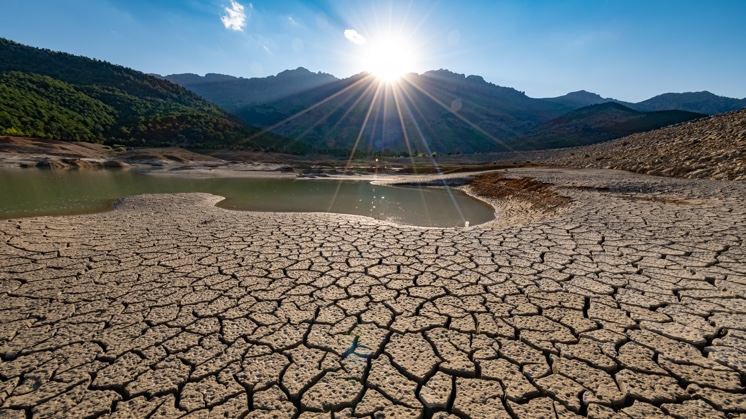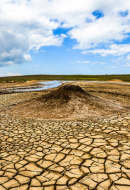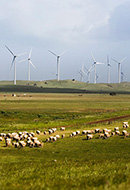Desertification
What is desertification? Discover its causes and consequences
The UN, which has been fighting desertification since 1994, defines it as the process of land degradation in arid, semi-arid and dry sub-humid areas as a result of various climatic and human factors. With climate change, these factors have only multiplied and it is now considered one of the world's major environmental problems.

6,000 years ago, the Sahara desert, now the largest desert in the world, was grassland covered with vegetation. The oscillations of the Earth's axis turned this area of the planet from an orchard to a sandy area where almost nothing can grow. In that case, we speak of a process of natural desertification which is in contrast to what is happening currently: large areas of the planet are being desertified at an accelerated rate as a result of human activity and climate change.
Definition of desertification
Desertification is the process by which vegetation in drylands i.e. arid and semi-arid lands, such as grasslands or shrublands, decreases and eventually disappears. The concept does not refer to the physical expansion of existing deserts, but to the various processes that threaten to turn currently non-desert ecosystems into deserts.
Human activities, including deforestation and the overexploitation of aquifers, accelerate desertification. The effects of climate change, which is also driven by humans, and the destruction it causes in the form of extreme weather phenomena such as droughts, hurricanes, fires, etc. must be added to this.
According to the UN, more than 24 billion tonnes of fertile soil disappear every year. In fact, today two-thirds of the Earth is undergoing a process of desertification and, if no action is taken, 1.5 million km2 of agricultural land, an area equivalent to the entire arable land of India, which is essential for maintaining biodiversity and feeding the population, will be lost by 2050.
Desertification and desertisation: differences
Although they are often used interchangeably, the difference lies in the human influence on the process. In desertisation, the causes of deterioration are strictly natural, as in the case of the Sahara mentioned above, but in desertification, although natural causes also play a role, human activities are a determining factor.
Causes of desertification
The main human activities driving desertification are:
Deforestation, causes of which go beyond tree felling, which increases the risk of fires, among others.
![]() Poor agricultural practices, from not rotating crops to unprotected soils or chemical fertiliser and pesticide use, etc.
Poor agricultural practices, from not rotating crops to unprotected soils or chemical fertiliser and pesticide use, etc.
Overexploitation of natural resources as a consequence, for example, of irresponsible management of vegetation or water.
Bad livestock practices, such as overgrazing, which severely erode the land and prevent the regeneration of vegetation.
Consequences of desertification
Drylands cover about half of the earth's ice-free land surface and many of them belong to the world's poorest countries, which exacerbates the consequences:
Loss of biodiversity by worsening the living conditions of many species.
Food insecurity due to crop failure or reduced yields.
![]() The loss of vegetation cover and therefore of food for livestock and humans.
The loss of vegetation cover and therefore of food for livestock and humans.
![]() Increased risk of zoonotic diseases, such as COVID-19.
Increased risk of zoonotic diseases, such as COVID-19.
Loss of forest cover, with a corresponding shortage of wood resources.
The decrease in drinking water reserves due to the loss of aquifers.
According to the United Nations Convention to Combat Desertification, the lives of 250 million people are already affected by desertification and up to 135 million could be displaced (climate migrations) by desertification by 2045, making it one of the most serious environmental problems facing humanity.
How to avoid desertification
Among the Sustainable Development Goals (SDGs) adopted by the UN is SDG 15 (Life of terrestrial ecosystems), which aims to protect, restore and promote the sustainable use of terrestrial ecosystems, sustainably manage forests, stop and reverse land degradation, combat desertification and stop biodiversity loss.
The solution at the local level to curb desertification is sustainable management of natural resources, especially the conservation of fertile soils and water resources. In this sense, some of the keys that can help to avoid desertification are:
- Promote coordinated land-use planning, including the management of water resources, livestock and agricultural activities.
- Preserve vegetation cover, which plays a key role in protecting the soil from wind and water erosion, by building barriers and stabilising dunes.
- Promote climate change education to raise awareness, in particular by showing the consequences of desertification and ways to prevent it.
- Focus on organic farming and sustainable practices, such as cover crops or rotational crops, which prevent soil erosion and drought.
- Commit to reforestation to regenerate vegetation cover, reactivate moisture circulation and generate biodiversity.
- Encourage rotational grazing, which limits pressure to a particular area while others regenerate, through co-existence with crops that allow more efficient nutrient cycling.
Iberdrola's fight against desertification
Iberdrola is committed to sustainability and the fight against desertification. Through its Trees programme, the company helped plant 3.4 M trees in seven countries between 2020 and 2023. The goal is to plant 20 M trees by 2030, which will capture approximately 6 M tonnes of CO₂ in 30 years.

Greenhouse effect
The consequences of the greenhouse effect: from desertification to floods

Origin of the COP
Why are there different COPs and what is their history?

Environmental issues
The big global environmental issues we need to resolve by 2030

Sustainable lifestyle
How to adopt a sustainable lifestyle? Tips for making a green commitment




